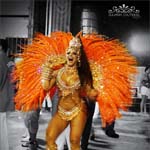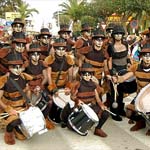Carnival
After the Rio de Janeiro version, Spain enjoys the world’s liveliest editions of the Carnival in Santa Cruz de Tenerife and Cadiz. Both of them are unique showcases of a very old event, that’s been occurring in one fashion or another since ancient times.
Origin
The Carnival, expression of freedom, liberation and inversion of the collective unconscious is a celebration as old as mankind, in one way or another. It the ancient Greece and Rome there were similar celebrations: the Bacchanalia, the Saturnalia and the Lupercalia.
Thought these kind of celebrations didn’t enjoy a continuity in the post-Christian era, the Carnival is somewhat directly connected to the time of Lent in the Christian world from Medieval times. The reason for this is that it is the last chance for satisfying all the appetites that the Christian moral will afterwards restrain. This is also deeply connected with the linear conception of time: Christianity proposes a "passional time order", in which moments of pain and joy alternate chronologically, depending on whether it's time of prohibition or tolerance. The Carnival is a direct consequence of this linear and simplistic conception of time. A conception adjusted to the life and crops cycles.
Santa Cruz de TenerifeCanary Islands

Santa Cruz de Tenerife is the second biggest and most renowned carnival festivity in the World, after Rio de Janeiro in Brazil. Though it probably existed since the first European settlements, the first written record of it dates back to the late XVIII century. Already in 1778 there is a record of a dance held in Santa Cruz de Tenerife in which the existence of krewes is mentioned, and in 1783 the use of masks was forbidden.
Later, during the two XX century dictatorships, the Carnival was renamed to "Winter Feasts", though the essence of the celebration remained more or less the same. After these grey times were past, the Carnival retook its denomination. Also during Franco's dictatorship, the first murga (a sort of popular orchestra that plays songs around the streets) was born, and still operates today. Since 1962, a poster is made every year to announce the celebration, and from 1987 there is a theme for each edition of the festival, around which revolves the whole aesthetic part of the feast.
We could say that the festival is divided in two: the official festival, and the side festival which is just the local people and the visitors having fun in the streets of Santa Cruz de Tenerife. One of the main attractions of the "official" fiesta is the Costume Contest, which takes place on Wednesday. There, the Queen of the festival is elected, paying a special attention to the fantasy costume specially designed for her by a local artisan. Then, on Friday, takes place the Announcement Parade, which strolls around the Santa Cruz' streets announcing the arrival of the Carnival on the next day. The Queen and her maids have their own carriage, surrounded by the murgas and krewes. There is music and drumming for about 4 hours, before the street party begins.
Saturday is a day dedicated entirely to dancing: two different stages are set up in the city's squares, and many Latin music bands perform during the whole day, while people drink and enjoy at the many stalls on the nearby streets. Then, Sunday is a day off in the celebrations, waiting for the main day of the Carnival, Monday, when many performances and events fill the venues set in the different locations of the city. Finally, Wednesday sees the end of the frenzy, in the so-called Burial of the Sardine, which marks the end of the carnival week. Even though, some other events related to it still happen until Sunday.
CadizAndalusia

The Carnival of Cadiz has en even older origin than the Santa Cruz de Tenerife edition, for its existence is documented as far back as the XVI century. It also had greater influence from its Italian correlates. From the XVIII century on, the struggles of the Carnival to live were constantly threatened by the authorities, which wanted to eradicate the feast for its highly subversive character (in Roman Catholic terms, that is). They had little succeed at this, and the Carnival kept taking place and growing bigger and more formed in structure and organization during the XIX century.
With the coming of the XX century, it experienced a similar luck as it brother in Tenerife, for the dictatorships tried to silence the sound of its drums, going as far as cancelling it. A curious event, though, unexpectedly brought it back to life: an accident at a nearby mine had struck the locals' spirit so, that the authorities decided to recover the tradition of the Carnival, changing its name to "Typical Fiestas of Cadiz". The coming of democracy in 1976 brought back the original format of the festival, and restored its name.
The Cadiz Carnival has its considerable differences with the one held in Tenerife. There is also a parade, a Queen of the festival is chosen (they call her "Goddess" in Cadiz), but the main attraction of the Cadiz festival are the chirigotas. The chirigotas are the typical krewes of the Cadiz Carnival, groups of singers and musicians that compose and perform their own, always very focused on the year's political and social events and that achieve great levels of originality and wit. They not only parade around the city's streets, but also compete in a huge contest, being the winner of is a great honour for the locals.
Both the Cadiz and the Santa Cruz de Tenerife editions are great examples of the Carnival tradition in Spain, and a great opportunity to enjoy a very popular fiesta. And remember, even though it takes place in Februray, you will also probably be able to enjoy an exceptionally warm weather!!!

 The myth of the world upside-down, the time for being someone else and the liberation of the instincts… this and much more is what you will find in Cadiz and Tenerife during their Carnival season.
The myth of the world upside-down, the time for being someone else and the liberation of the instincts… this and much more is what you will find in Cadiz and Tenerife during their Carnival season. 